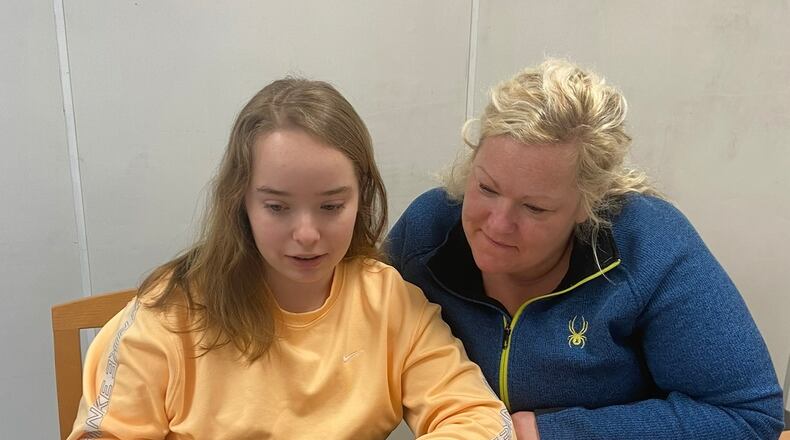Last year, students and families couldn’t access the FAFSA until January. Once families could access the form, some struggled to submit the documents.
FAFSA problems could mean more than just frustrated families. It could also impact students’ ability to make a good financial decision with college since offers came later than normal in the spring, and some families could lose confidence the FAFSA will help students. Fewer kids going to college could impact the Dayton economy.
Last year, schools sent back financial aid offers in late April, when the traditional commitment day is May 1. Ashley Overman, College Access Coordinator at the Montgomery County Educational Services Center, said students who are low-income need time to make a price comparison among their potential universities.
“They don’t have that luxury,” Overman said. “They didn’t last year, and I worry that they won’t have it again this year, and that creates real systemic problems.”
According to Ohio FAFSA by the Numbers, the state’s overall submission rate was 56% as of Aug. 20, 6% down compared to the previous year. The national year-to-date submission rate is 52%, so Ohio is 4% ahead of the national numbers.
In Montgomery County, 59% of students submitted FAFSAs, but that number is down 8% compared to the previous year.
“We want to be sure that Ohio students are not leaving money on the table that could help them achieve their educational and career dreams,” Ohio Department of Higher Education chancellor Mike Duffey said in a press release in July encouraging students to complete the FAFSA.
Knowing how hard filling out the FAFSA application was when I was in college and how complicated the process is already for families, I felt badfor the students I talked to earlier this year who struggled through the process.
And talking to some school counselors, I wonder how much better it will be this year.
Alexandria Burns is the director of programs and operations for Bottom Line, which is a nonprofit new to Dayton focused on helping kids from under resourced backgrounds with average grades get into and complete college. Bottom Line is targeting schools like Dayton Public’s high schools and Wright State University.
Bottom Line is a national nonprofit, but the other programs are in New York City, Chicago, and Boston. It came to Dayton on a grant from The Connor Group – Kids & Community Services.
Burns said one of the biggest barriers to students this coming year will be building confidence in the FAFSA application process.
“They (students) already saw their peers go through glitches and tech issues,” Burns said. “I believe the (Federal Student Aid) office will have to build back buy in.”
On top of the application barrier, college students fear college debt, and rightly so. According to the Education Data Initiative, it takes an average of 20 years to pay back student loans.
According to the same data, 21% of borrowers see a total student loan balance increase in the first five years of paying off loans.
This data includes graduate school loans, medical and law school, which isn’t what many high school students are thinking about immediately after college. Still, even a regular student loan payment over 10 years can seem daunting in the face of inflating costs of housing and food.
Of course, students don’t have to go to college, and increasingly, many are not. Students are choosing to go right into the workforce or do trades in high school that lead them into jobs. Some might pick a community college over a four-year bachelor’s degree. (Community colleges accept federal dollars for trade schools through the FAFSA.)
Students should have a choice between a four-year degree and a trade. But from a regional perspective, multiple high-tech jobs coming to the area will need college and advanced degrees.
Last week, Ohio Gov. Mike DeWine announced an “innovation hub,” the second in the state, as part of the University of Dayton and Premier Health’s plan for the OnMain project, located at the former Montgomery County Fairgrounds.
Joby Aviation, Intel and Honda have all announced plans for jobs to come to southwest and central Ohio. Those plants will likely require support from outside agencies, which will also need skilled workers.
“Just think about that, how as a state, are we going to continue to funnel kids into these opportunities?” Overman said.
She noted there are many scholarships available for Ohio kids who go to Ohio schools and major in a state-deemed “in-demand” job, like the Governor’s Merit Scholarship and the Choose Ohio First scholarship.
It’s worth noting what fewer college students means to the Dayton economy, with several major universities so close. The University of Dayton, Wright State University, Miami University, Central State University, Wittenberg University and Cedarville University are just a few of those in our region alone. They employ thousands of people and business ecosystems have popped up to cater to the students and university staff.
For families who are struggling to fill out the FAFSA, high school counselors should be the first point of contact. University financial aid offices may also be a good resource.
Overman works with students in Montgomery County, specializing in more complicated forms, and can be contacted via the Montgomery County Educational Service Center website.
Bottom Line will work with their own students.
The state of Ohio has more information at www.itsforyou.org/.
Overman and Burns hope they’re wrong about how hard the FAFSA could be this year.
“The first rollout was supposed to be a simple application and remove complexities but instead they created more,” Burns said. “I hope the revisions are easy to navigate and students and families do not find the FAFSA harder to navigate.”
About the Author

